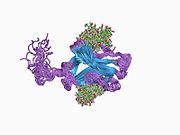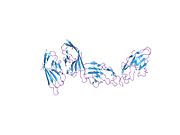Cytotoxic T-lymphocyte associated protein 4
This article may be too technical for most readers to understand. (September 2017) |
Ensembl | |||||||||
|---|---|---|---|---|---|---|---|---|---|
| UniProt | |||||||||
| RefSeq (mRNA) | |||||||||
| RefSeq (protein) | |||||||||
| Location (UCSC) | Chr 2: 203.85 – 203.87 Mb | Chr 1: 60.93 – 60.95 Mb | |||||||
| PubMed search | [3] | [4] | |||||||
| View/Edit Human | View/Edit Mouse |
Cytotoxic T-lymphocyte associated protein 4, (CTLA-4) also known as CD152 (
The CTLA-4 protein is encoded by the Ctla-4 gene in mice.[6][7]
History
CTLA-4 was first identified in 1991 as a second receptor for the T cell costimulation ligand B7.[8] In November 1995, the labs of Tak Wah Mak and Arlene Sharpe independently published their findings on the discovery of the function of CTLA-4 as a negative regulator of T-cell activation, by knocking out the gene in mice.[9][10] Previous studies from several labs had used methods which could not definitively define the function of CTLA-4, and were contradictory.[11]
Function
CTLA-4 is a member of the
The mechanism by which CTLA-4 acts in T cells remains somewhat controversial. Biochemical evidence suggested that CTLA-4 recruits a phosphatase to the T cell receptor (TCR), thus attenuating the signal.[17] This work remains unconfirmed in the literature since its first publication. More recent work has suggested that CTLA-4 may function in vivo by capturing and removing CD80 and CD86 from the membranes of antigen-presenting cells, thus making these unavailable for triggering of CD28.[18]
In addition to that, it has been found that dendritic cell (DC) - Treg interaction causes sequestration of Fascin-1, an actin-bundling protein essential for immunological synapse formation and skews Fascin-1–dependent actin polarization in antigen presenting DCs toward the Treg cell adhesion zone. Although it is reversible upon T regulatory cell disengagement, this sequestration of essential cytoskeletal components causes a lethargic state of DCs, leading to reduced T cell priming. This suggests Treg-mediated immune suppression is a multi-step process. In addition to CTLA-4 CD80/CD86 interaction, fascin-dependent polarization of the cytoskeleton towards DC-Treg immune synapse may play a pivotal role.[19]
CTLA-4 may also function via modulation of cell motility and/or signaling through PI3 kinase[20] Early multiphoton microscopy studies observing T-cell motility in intact lymph nodes appeared to give evidence for the so-called ‘reverse-stop signaling model’.[21] In this model CTLA-4 reverses the TCR-induced ‘stop signal’ needed for firm contact between T cells and antigen-presenting cells (APCs).[22] However, those studies compared CTLA-4 positive cells, which are predominantly regulatory cells and are at least partially activated, with CTLA-4 negative naive T cells. The disparity of these cells in multiple regards may explain some of these results. Other groups who have analyzed the effect of antibodies to CTLA-4 in vivo have concluded little or no effect upon motility in the context of anergic T-cells.[23] Antibodies to CTLA-4 may exert additional effects when used in vivo, by binding and thereby depleting regulatory T cells.[24]
Structure
The protein contains an
Clinical significance
Variants in this gene have been associated with
Polymorphisms of the CTLA-4 gene are associated with autoimmune diseases such as rheumatoid arthritis,[25] autoimmune thyroid disease and multiple sclerosis, though this association is often weak. In systemic lupus erythematosus (SLE), the splice variant sCTLA-4 is found to be aberrantly produced and found in the serum of patients with active SLE.
Germline haploinsufficiency
CTLA-4 mutations are inherited in an
Clinical and laboratory manifestations
Symptomatic patients with CTLA-4 mutations are characterized by an immune dysregulation syndrome including extensive T cell infiltration in a number of organs, including the gut, lungs, bone marrow, central nervous system.[28][29] and kidneys. Most patients have diarrhea or enteropathy. Lymphadenopathy and hepatosplenomegaly are also common, as is autoimmunity. The organs affected by autoimmunity vary but include thrombocytopenia, hemolytic anemia, thyroiditis, type I diabetes, psoriasis, and arthritis. Respiratory infections are also common. Importantly, the clinical presentations and disease courses are variable with some individuals severely affected, whereas others show little manifestation of disease. This “variable expressivity,” even within the same family, can be striking and may be explained by differences in lifestyle, exposure to pathogens, treatment efficacy, or other genetic modifiers.[26][27][30][31] This condition is described to have incomplete penetrance of disease. Penetrance is said to be incomplete when some individuals fail to express the trait and seem completely asymptomatic, even though they carry the allele. The penetrance is estimated to be about 60%.
The clinical symptoms are caused by abnormalities of the immune system. Most patients develop reduced levels of at least one
Treatment
Once a diagnosis is made, the treatment is based on an individual’s clinical condition and may include standard management for autoimmunity and immunoglobulin deficiencies. A study reported in 2016 treated a Korean CHAI disease patient with abatacept, which is a fusion protein of CTLA-4 and an antibody, and was able to control immune activity and improve patient symptoms. Regular administration of abatacept improved the patient’s severe anemia and diarrhea (3L/day) and brought 3-year-long hospitalization to an end.[31]
Agonists to reduce immune activity
The comparatively higher binding affinity of CTLA-4 than that of CD28 has made CTLA-4 a potential therapy for
Antagonists to increase immune activity
Conversely, there is increasing interest in the possible therapeutic benefits of blocking CTLA-4 (using antagonistic antibodies against CTLA such as
The 2018 Nobel Prize in Physiology or Medicine was awarded to James P. Allison and Tasuku Honjo "for their discovery of cancer therapy by inhibition of negative immune regulation".[34]
Interactions
CTLA-4 has been shown to
References
- ^ a b c GRCh38: Ensembl release 89: ENSG00000163599 – Ensembl, May 2017
- ^ a b c GRCm38: Ensembl release 89: ENSMUSG00000026011 – Ensembl, May 2017
- ^ "Human PubMed Reference:". National Center for Biotechnology Information, U.S. National Library of Medicine.
- ^ "Mouse PubMed Reference:". National Center for Biotechnology Information, U.S. National Library of Medicine.
- ^ PMID 29208439.
- S2CID 4316396.
- S2CID 34071559.
- PMID 17632849.
- ^ S2CID 45993765.
- PMID 7584144.
- PMID 23160205.
- PMID 7543139.
- PMID 8676075.
- PMID 7882171.
- S2CID 4333730.
- PMID 10556814.
- PMID 9856951.
- PMID 21474713.
- PMID 28082358.
- PMID 22412835.
- S2CID 27123046.
- PMID 19426212.
- PMID 19783989.
- PMID 23897981.
- PMID 30224649.
- ^ PMID 25213377.
- ^ PMID 25329329.
- PMID 34097529.
- PMID 33956248.
- PMID 25367873.
- ^ PMID 26478010.
- PMC 2833769.
- PMID 22437870.
- ^ "The Nobel Prize in Physiology or Medicine 2018". NobelPrize.org. Retrieved 3 July 2023.
- PMID 11583591.
- S2CID 25449038.
- PMID 7545666.
- S2CID 4329622.
- PMID 11994459.
Further reading
- Liossis SN, Sfikakis PP, Tsokos GC (August 1998). "Immune cell signaling aberrations in human lupus". Immunologic Research. 18 (1): 27–39. S2CID 13581332.
- Chang TT, Kuchroo VK, Sharpe AH (2002). "Role of the B7-CD28/CTLA-4 pathway in autoimmune disease". Signal Transduction Pathways in Autoimmunity. Current Directions in Autoimmunity. Vol. 5. pp. 113–30. PMID 11826754.
- Alizadeh M, Babron MC, Birebent B, Matsuda F, Quelvennec E, Liblau R, et al. (July 2003). "Genetic interaction of CTLA-4 with HLA-DR15 in multiple sclerosis patients". Annals of Neurology. 54 (1): 119–22. S2CID 9216025.
- Chistiakov DA, Turakulov RI (August 2003). "CTLA-4 and its role in autoimmune thyroid disease". Journal of Molecular Endocrinology. 31 (1): 21–36. PMID 12914522.
- Vaidya B, Pearce S (May 2004). "The emerging role of the CTLA-4 gene in autoimmune endocrinopathies". European Journal of Endocrinology. 150 (5): 619–26. PMID 15132716.
- Brand O, Gough S, Heward J (October 2005). "HLA , CTLA-4 and PTPN22 : the shared genetic master-key to autoimmunity?". Expert Reviews in Molecular Medicine. 7 (23): 1–15. S2CID 841442.
- Kavvoura FK, Akamizu T, Awata T, Ban Y, Chistiakov DA, Frydecka I, et al. (August 2007). "Cytotoxic T-lymphocyte associated antigen 4 gene polymorphisms and autoimmune thyroid disease: a meta-analysis". The Journal of Clinical Endocrinology and Metabolism. 92 (8): 3162–70. PMID 17504905.
External links
- Human CTLA4 genome location and CTLA4 gene details page in the UCSC Genome Browser.
- Overview of all the structural information available in the PDB for UniProt: P16410 (Cytotoxic T-lymphocyte protein 4) at the PDBe-KB.
This article incorporates text from the United States National Library of Medicine, which is in the public domain.



